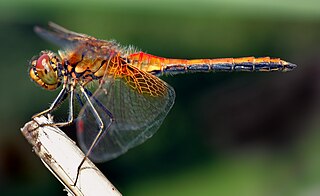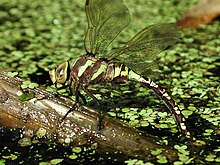
A dragonfly is a flying insect belonging to the order Odonata, infraorder Anisoptera. About 3,000 extant species of true dragonfly are known. Most are tropical, with fewer species in temperate regions. Loss of wetland habitat threatens dragonfly populations around the world. Adult dragonflies are characterized by a pair of large, multifaceted compound eyes, two pairs of strong, transparent wings, sometimes with coloured patches, and an elongated body. Many dragonflies have brilliant iridescent or metallic colours produced by structural colouration, making them conspicuous in flight. An adult dragonfly's compound eyes have nearly 24,000 ommatidia each.

The skimmers or perchers and their relatives form the Libellulidae, the largest dragonfly family in the world. It is sometimes considered to contain the Corduliidae as the subfamily Corduliinae and the Macromiidae as the subfamily Macromiinae. Even if these are excluded, there remains a family of over 1000 species. With nearly worldwide distribution, these are almost certainly the most often seen of all dragonflies.

The Gomphidae are a family of dragonflies commonly referred to as clubtails or club-tailed dragonflies. The family contains about 90 genera and 900 species found across North and South America, Europe, Asia, and Australia. The name refers to the club-like widening of the end of the abdomen. However, this club is usually less pronounced in females and is entirely absent in some species.

Sympetrum is a genus of small to medium-sized skimmer dragonflies, known as darters in the UK and as meadowhawks in North America. The more than 50 species predominantly live in the temperate zone of the Northern Hemisphere; no Sympetrum species is native to Australia.

Cefn Blaenau is a 23-hectare Site of Special Scientific Interest in a small upland valley in Carmarthen and Dinefwr, Wales. It was designated an SSSI in 1989, primarily for its flush and spring vegetation as well as the diverse mosaic of unimproved pasture, ‘ffridd’ land, marshy grassland, wet heath, acid grassland, broadleaved woodland, streams, and small rock outcrops. These habitats, which are well represented at this site, have been greatly reduced in north Carmarthenshire due to land improvement, agricultural intensification, and afforestation. Only about 140 hectares of flush and spring vegetation remain in the county.

















